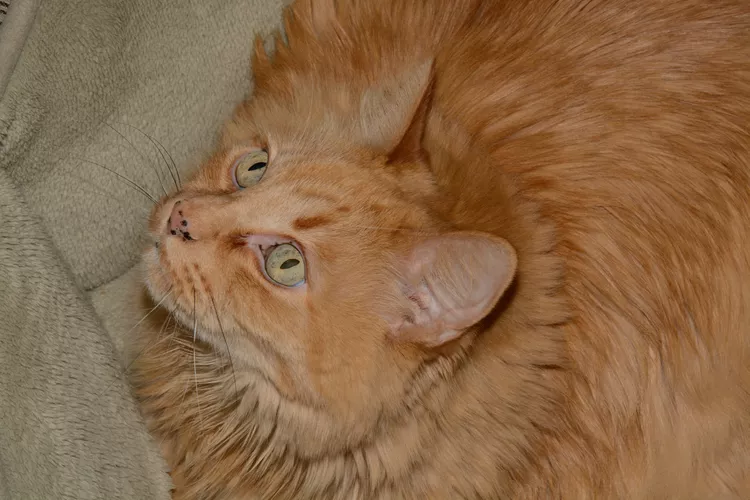What Are the Black Spots on My Orange Cat's Mouth & Nose?

A new spot that pops up on your cat usually causes worry, but the spots can often be easily explained. The most common reason for these dark spots is lentigo, a genetic condition in which the number of epidermal melanocytes increases.
In the case of flat brown or black spots that suddenly appear on your orange cat’s nose, lips, and eyelid margins, you may be worrying over nothing. Let’s find out what these spots are and whether you should be concerned.
Why Do Orange Cats Have Black Spots?
The most common reason for these dark spots is lentigo, a genetic condition in which there is an increase in the number of epidermal melanocytes. As these pigment-producing cells multiply, small black or brown spots appear on your cat’s face.
Orange cats are not the only color affected by lentigo. Black spots can also pop up on tortoiseshell, calico, yellow, and flame-point cats. Middle-aged to older cats are most commonly affected, but lentigo can appear in cats as young as a year old.
What Are the Signs of Lentigo in Cats?
When lentigo first appears in cats, it often pops up on the lips as tiny dots, before spreading to the eyelids, gums, and nose. As the cat ages, the spots become more widespread and may grow larger. Often, a small cluster of spots will grow together to form a large patch of pigment.
Small lesions may appear close together, discoloring a larger area. They are either brown or black, small in size, and usually flat, but they may appear raised. With a clearly defined border, there is no redness or other skin changes surrounding the lesions. Cats also appear to be comfortable with these “freckles,” as they do not seem to be itchy or irritating.
What Are the Causes of Lentigo in Cats?
While freckles are associated with sun exposure in people, the exact cause of lentigo in cats is unknown. The appearance of these feline freckles does not seem to coincide with increased sun exposure.
Regardless of the underlying trigger, lentigo spots result from pigment-producing cells called melanocytes making more melanin than the surrounding skin. It is thought that the gene that codes for orange coat color is unstable and reverts back to its more natural "non-orange," dark gene over time, but this theory has not been confirmed.
How Is Lentigo in Cats Diagnosed and Treated?
Veterinarians often diagnose lentigo based on a thorough physical exam, the presenting clinical signs, and by checking for any other health conditions. Occasionally, lentigo spots can appear similar to melanoma, so your veterinarian may take a fine needle aspirate of a suspicious spot to search for cancerous cells under the microscope.
Lentigo is not a form of cancer, nor will it grow to become cancer. The only concern is that lentigo spots can mask melanoma spots, which makes routine veterinary exams critical for monitoring. If you notice a raised black spot on your cat, contact your veterinarian, as raised spots tend to be cancerous more often than flat spots.
Since lentigo is a benign, cosmetic condition, like human freckles or age spots, there is no need for treatment—simply enjoy your kitty’s freckles.
What Other Conditions Appear Similar to Lentigo in Cats?
While the black spots caused by lentigo can be startling, they are the most benign condition that appears as small black dots. Other similar-appearing medical issues that can create health problems include:
Fleas and flea dirt
These blood-sucking parasites appear as small black dots in your cat’s fur and may be difficult to detect if she is an excellent groomer. As the fleas feed on your cat, they will pass digested blood, also known as flea dirt or excrement, which will appear as minuscule black flecks on your pet’s skin and fur.
Combing your cat with a fine-toothed flea comb is the best way to diagnose a flea issue, as these special combs are designed to pull fleas, eggs, and dirt off your pet.
Feline acne
While the exact cause of feline acne is unknown, it is a fairly common skin condition in cats. Appearing as black dots on the chin, feline acne may also progress to red, inflamed pustules that can rupture and ooze.
Proper hygiene is a must for cats with acne, especially regarding food and water dishes. Avoid plastic dishes and switch to ceramic, stainless steel, or glass instead. Feline acne can be an occasional flare-up or a chronic condition that requires rigorous hygiene protocols.
Melanoma
Cats, unlike people, rarely develop melanoma because of excessive sun exposure. Melanoma refers to the pigment melanin, which is produced by certain cells in the body. With the malignant form of melanoma, these pigment cells grow out of control, and are most likely to affect the skin, eyes, or mouth of cats.
Several characteristics are common among cats with melanoma:
- Melanoma may appear as a darkly colored patch, spot, lump, or raised area on the skin, gums, or within the eye.
- Commonly affected sites include the lips, gums, tongue, nose, ears, and eyes.
- In the eye, the first sign of melanoma may be the iris changing color and darkening.
- Melanoma is aggressive and can rapidly spread to the lungs or liver, causing breathing difficulties, lack of appetite, and weight loss.
If you're concerned about a spot on your cat, especially if it changes in size or is raised or tender, contact your veterinarian to schedule an appointment. There’s a good chance that your cat’s black spot may simply be lentigo, but it’s better to be safe than sorry.